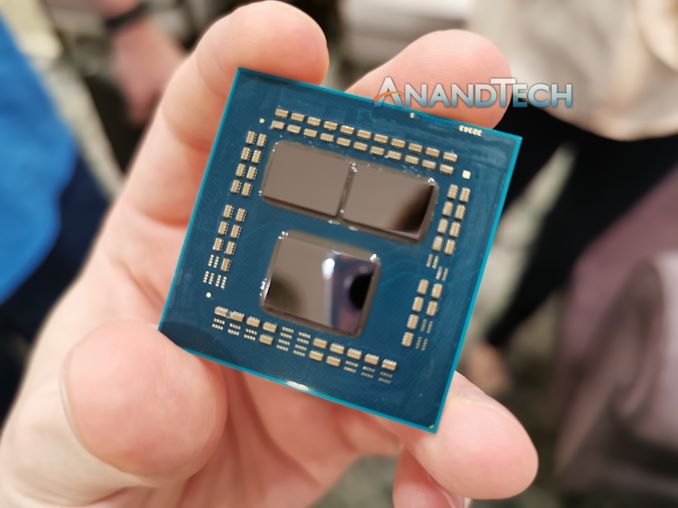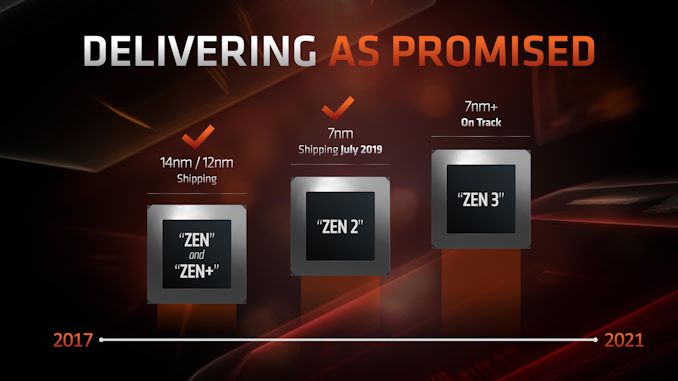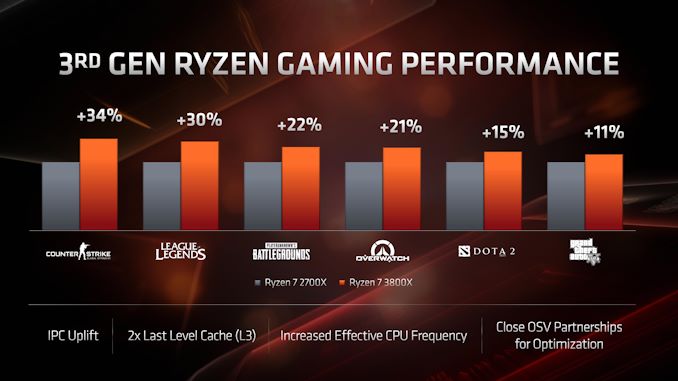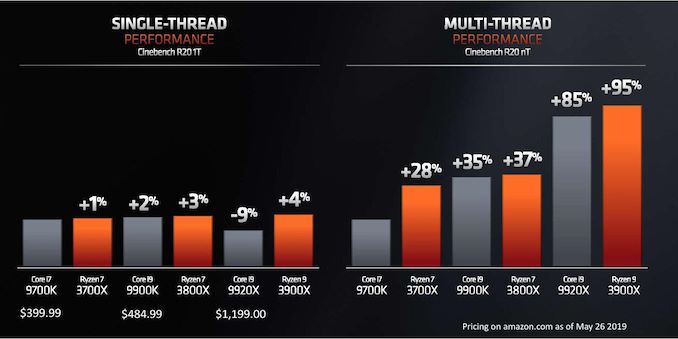The AMD 3rd Gen Ryzen Deep Dive Review: 3700X and 3900X Raising The Bar
by Andrei Frumusanu & Gavin Bonshor on July 7, 2019 9:00 AM EST
It’s the review we’ve all been waiting for. Since December last year – and particularly since CES – AMD has been teasing us about the new Zen 2 microarchitecture and AMD’s newest Ryzen 3000 series of CPUs. Incorporating a significantly upgraded CPU architecture and built using TSMC's latest generation manufacturing process, AMD has continued to run at full speed at a time when rival Intel has struggled to move at all. The end result is that while the first and second generation of Ryzen CPUs were all about AMD returning to competition and eating into Intel's substantial performance lead, the Ryzen 3000 series is nothing less than AMD's first shot in nearly 13 years at meeting (or beating) Intel at their own game in the desktop CPU market. It's a big moment for AMD, and an exciting one in the CPU industry as a whole.
The new Ryzen 3000 chips mark the first "big" leap for AMD since they introduced their first Ryzen processors a bit over two years ago. Unlike last year's Ryzen 2000 series, which was a more minor refresh and brought some tweaks to the microarchitecture and process node, this year’s Ryzen 3000 is a major upgrade for both CPU architecture as well as on the manufacturing node. It marks AMD’s switch from GlobalFoundries' 12nm process to TSMC’s newest 7nm node. But what’s more exciting is how AMD was able to actually implement this switch: Ryzen 3000 isn’t merely a single chip, but a collection of non-uniform chiplets, introducing this design paradigm in a consumer product for the first time.
Today AMD launches its entire new CPU lineup and platform, alongside the new Navi-based Radeon RX 5700 series. In terms of CPU coverage, we’ll be taking a closer look at the new flagship, the $499 12-core Ryzen 3900X, as well as the $329 8-core Ryzen 7 3700X and its peculiar low TDP of 65W.
Updates
- (7/8): We've noticed large frequency boost behaviour changes with new motherboard firmware that was released on launch day (7/7). We are currently re-running all our test suite numbers and updating the article with the new data soon as applicable. For further details please read here.
- (7/9): We've updated the article benchmark numbers on the 3900X. We've seen 3-9% improvements in exclusive ST workloads. MT workloads have remained unchanged, Gaming had both benefits and negatives. We continue to work on getting updated 3700X numbers. Original BIOS results are marked with ** in the graphs.
- (7/10): We've updated 3700X results as well. Ultimately our conclusions haven't changed, but AMD does narrow the gap a bit more. For a full summary of our findings, please check out this article.
The CPU Line-up
| AMD 'Matisse' Ryzen 3000 Series CPUs | |||||||||||
| AnandTech | Cores Threads |
Base Freq |
Boost Freq |
L2 Cache |
L3 Cache |
PCIe 4.0 |
Chiplets IO+CPU |
TDP | Price (SEP) |
||
| Ryzen 9 | 3950X | 16C | 32T | 3.5 | 4.7 | 8 MB | 64 MB | 16+4+4 | 1+2 | 105W | $749 |
| Ryzen 9 | 3900X | 12C | 24T | 3.8 | 4.6 | 6 MB | 64 MB | 16+4+4 | 1+2 | 105W | $499 |
| Ryzen 7 | 3800X | 8C | 16T | 3.9 | 4.5 | 4 MB | 32 MB | 16+4+4 | 1+1 | 105W | $399 |
| Ryzen 7 | 3700X | 8C | 16T | 3.6 | 4.4 | 4 MB | 32 MB | 16+4+4 | 1+1 | 65W | $329 |
| Ryzen 5 | 3600X | 6C | 12T | 3.8 | 4.4 | 3 MB | 32 MB | 16+4+4 | 1+1 | 95W | $249 |
| Ryzen 5 | 3600 | 6C | 12T | 3.6 | 4.2 | 3 MB | 32 MB | 16+4+4 | 1+1 | 65W | $199 |
AMD is launching 5 different SKUs today, with the 16-core Ryzen 9 3950X set to follow sometime in September. For today's launch AMD sampled the R9 3900X and R7 3700X, and we took them for a ride in the limited time we had with them, covering as much as we could.
Starting at the top we have the Ryzen 3900X, which is a 12-core design. In fact it's the first 12-core processor in a standard desktop socket, and it rather unique within AMD's product stack because it is currently the only SKU which takes full advantage of AMD’s newest chiplet architecture. Whereas all the other Ryzen parts are comprised of two chiplets – the base I/O die and a single CPU chiplet – 3900X comes with two such CPU chiplets, granting it (some of) the extra cores and the 64MB of L3 cache that entails.
Interestingly, while AMD has increased the core-count by 50% over its previous flagship processor, it has managed to keep the TDP to the same 105W as on the Ryzen 2700X. On top of this, the chip clocks in 300MHz faster than the predecessor in terms of boost clock, now reaching 4.6GHz; even the base clock has been increased by 100MHz, coming in at 3.8GHz. The big question then, is whether the new 7nm process node and Zen 2 are really this efficient, or should we be expecting more elevated power numbers?
Meanwhile our second chip of the day is the new Ryzen 3700X, which is configured and positioned as a particularly efficient model. With a boost clock of 4.4GHz and a base clock of 3.6GHz, the part should still be notably faster than the Ryzen 2700X, yet AMD has managed to make this a 65W TDP part which is going to make for some interesting analysis.
Continued Execution
Today’s Zen 2 and Ryzen 3000 launch is another step forward on AMD’s roadmap. The company has been working on a very ambitious development roadmap for their CPU designs, and Zen 2 is the company's first chance to flex their muscles and do a full iteration on their CPU core design.
Executing on this roadmap has been important for AMD both because it's helped them close the performance gap with Intel, and because it's helped to prove to customers (particularly hyperscalers and enterprises) that Zen wasn't a fluke, and that the company can reliably continue to improve its technology. This is especially noteworthy because while rival Intel hasn't been standing still, all of Intel's desktop technology for the last 3 years has been based on the same Skylake core architecture and variations on Intel's exceptional-for-the-time 14nm process. This will eventually change, as Intel gets their desktop house in order for 2020, but right now AMD is moving forward when Intel can not, allowing AMD to take full advantage of Intel's run of bad luck and wooing customers in the process.
And of course, AMD isn't done here. For the company’s engineers, today’s chips are last year’s work, and the company is working on the next generation Zen 3 core. Zen 3 is still a full generation away – and today is all about Zen 2 – but AMD is making it clear that Zen 2 isn't the end of the road either, and that they are working to further improve their CPU microarchitecture and overall platform.
Large Performance Boosts, Particularly for Gaming
The 3rd gen Ryzen processors promise to bring some notably large performance improvements for users. The Zen 2 core microarchitecture is said to bring over 10% IPC improvements; this together with the higher clockspeeds should make for some solid generational improvements in a lot of workloads. For gaming in particular, AMD claims that we should be seeing some large improvements – the doubled size of the L3 cache is said to have made a notable mark on a lot of gaming titles, with AMD claiming ~20% to even ~30% improvements in some titles when compared to the last generation Ryzen 2700X.
The Ryzen 3000 Competition: Intel's Coffee Lake Refresh
Positioning the Ryzen 3000 series against Intel’s line-up is a matter of both performance as well as price. AMD had already made comparisons between the new SKUs and Intel’s counterparts back at Computex, where we saw comparisons between similarly priced units. According to the company, even Intel's pricey Skylake high-end desktop (HEDT) processor, the Core i9-9920X, isn't entirely out of the line of fire of the Ryzen 3900X.
As a quick recap to where things stand, compared to its immediate predecessor, Intel’s Coffee Lake Refresh received quite a bump in terms of both clock frequencies as well core counts. This allowed Intel to erase any Ryzen 2000 series lead in multi-threaded performance, all the while still maintaining a comfortable lead in single-threaded performance.
Against the Ryzen 3000 series, the Intel line-up will seemingly no longer have an IPC lead. AMD hasn’t been in such a situation since the Athlon 64 days well over 15 years ago, which is a remarkable turn of events. But with that said, make no mistake: IPC is just one half of the equation for single-threaded performance, and the other is raw frequency, and the Intel line-up still has a notable advantage thanks to its peak frequencies of up to 5GHz. So taking over Intel's single-threaded performance lead (at least on a consistent basis) is a tall order for the Ryzen 3000 series.
| Comparison: Ryzen 9 3900X vs Core i9-9900K | ||
| AMD Ryzen 9 3900X |
Features | Intel Core i9-9900K |
| 12 / 24 | Cores/Threads | 8 / 16 |
| 3.8 / 4.6 GHz | Base/Turbo | 3.6 / 5.0 GHz |
| 16 (Free) + 4 (NVMe) | PCIe 4.0 Lanes | 16 (Free) Gen 3.0 (No Gen 4.0) |
| 512 KB/core | L2 Cache | 256 KB/core |
| 4x 16 MB 64 MB total |
L3 Cache | 16 MB |
| 105 W | TDP | 95 W |
| $499 (cooler included) |
Price (List) | $484 (no cooler) |
Taking a look at chip pricing and positioning then, the big flagship fight among desktop processors is going to be between the Ryzen 3900X at $499, and the i9-9900K at $484. Both of which happen to be the highest-end SKUs of their respective mainstream desktop computing platforms. It's to remembered that the AMD CPUs come with a good cooler included, while Intel's options don't include one, meaning one would have to spend extra in order to get the Intel system running.
Here AMD should have a significant lead in terms of the multi-threaded performance of the new Ryzen 9 series as it’s able to employ 50% more cores than Intel, all while promising to remain in a similar TDP range of 105W vs 95W. We still expect the 9900K to win some workloads which are more lightly threaded simply due to Intel’s clock frequency lead, however this is something we’ll investigate more in detail in the coming benchmark analysis.
| Comparison: Ryzen 7 3700X vs Core i7-9700K | ||
| AMD Ryzen 7 3700X |
Features | Intel Core i7-9700K |
| 8 / 16 | Cores/Threads | 8 / 8 |
| 3.6 / 4.4 GHz | Base/Turbo | 3.6 / 4.9 GHz |
| 16 (Free) + 4 (NVMe) | PCIe 4.0 Lanes | 16 (Free) Gen 3.0 (No Gen 4.0) |
| 512 KB/core | L2 Cache | 256 KB/core |
| 2x 16 MB 32MB total |
L3 Cache | 12 MB |
| 65 W | TDP | 95 W |
| $329 (cooler included) |
Price (List) | $385 (no cooler) |
The Ryzen 7 3700X is an interesting SKU. With only one populated CPU chiplet, the unit has half the available L3 cache versus the Ryzen 9 3900X. But it also has all the CPU cores within its one chiplet active. In theory this does mean that the CPU cores have less overall L3 cache available to them, as they have to share it with an additional core within their respective CCXs.
With a 3.6GHz/4.4Ghz base/boost clock configuration, we expect the 3700X to outperform the previous generation 2700X in all scenarios. The competition here based on pricing is the Core i7-9700K. Intel again should have a single-threaded performance advantage thanks to its 500 MHz higher clocks – but we’ll have to see how both chips match up in daily workloads.
The Zen 2 µarch Overview: Read Our Dedicated Article
We’ve already posted a microarchitecture overview and analysis of the Zen 2 microarchitecture following our Tech Day briefings in June, so be sure to read the piece in preparation for further testing analysis in our review today:













447 Comments
View All Comments
Korguz - Tuesday, July 9, 2019 - link
what ever phynaz... anandtech did a write up on the power intel uses for their chips : https://www.anandtech.com/show/13544/why-intel-pro...that link you posted, looks like a mistake was made with communication between several different parties, as the poster said, considering this is a new cpu, and accompanying mobo/chipset, things like this do happen, even intel has had its own issues with a new platform, and we will have to see how it levels off in the coming few weeks. amd does stay within its TDP limits better then intel.. at least when amd says their cpus use XXX watts, it uses around that number, unlike intel, where a 95watt cpu, cause use up to 200 watts, as the link i posted shows...
you sure like to throw insults around dont you ? does it make you feel better about your self ? in the end.. maybe its YOU that cant handle the truth about your beloved intel ? face it, compared to zen2/ryzen 3, intels cpus use more power, and cost LESS then intels equivalent cpu, and amd has IPC parity with intel.
Xyler94 - Wednesday, July 10, 2019 - link
Phynaz... you may wanna rethink your TDP argument there...Intel's i9 9900k's TDP is 95W, however regularly hits over 200W without an overclock.
just4U - Monday, July 8, 2019 - link
The silver award seems apt. Since it certainly lived up to expectations and in some instances surpasses them. gold if it's the clear winner in everything, platinum if it beats out all expectations..Meteor2 - Monday, July 15, 2019 - link
Ryzen 3000 beats Intel ST and MT per Watt or per dollar, which are the only metrics which matter. Otherwise how are you comparing like with like?patmanRR - Sunday, July 7, 2019 - link
Using llvm for c/c++/Fortran codes is most likely to result in slower performance than gcc (and even more likely than Intel compilers) .I do not know if the performance impact is more/less/the same among Intel and and CPUs but I do not really trust these numbers in the first pages of the review.Dragonsteel - Sunday, July 7, 2019 - link
I'm excited by the 3800X, which based on this article, may showcase a much higher performance (and power) output at higher multi threaded applications.I'm very much looking forward to the inclusion of the 3800X numbers. Would also like to see some game updates with the 2080 and such at 1440p as most of the test either skipped that resolution and went to 4K. The 4K results mostly showed the GPU bottleneck.
danjw - Sunday, July 7, 2019 - link
I was really looking forward to reading this review. I look forward to finding out what is going on with your PCMark numbers. I appreciate that you guys are willing to go the extra mile when you see something not looking right. Thank you and keep up the great work guys!AshlayW - Sunday, July 7, 2019 - link
Great review, thanks. Gains are good but I'm more than happy with my 2700X for now so I'll likely be waiting for Ryzen 4000. Seems like Intel CPUs are more or less obsolete at their current prices now unless you absolutely need the best possible gaming performance at any cost. (more money than sense).One nitpick, though. I completely disagree with this statement:
"Ultimately, while AMD still lags behind Intel in gaming performance, the gap has narrowed immensely, to the point that Ryzen CPUs are no longer something to be dismissed if you want to have a high-end gaming machine."
Specifically, about "dismissing" AMD Ryzen CPUs for high end gaming machines, I mean the 2nd and 1st gen ones. I have built many "high end" gaming machines, with Ryzen 1800X and 2700X and they are excellent. Anyone that "dismisses" Ryzen 1 or 2 for a high end gaming machine is a tool. (I'm gaming at 144Hz on a 2700X, lol).
But I understand the point trying to be made. Gaming was the last bastion for Ryzen in absolute performance and now they have sort of cracked it. 9900K for 480+ bucks is going to be a hard sell with these new chips onm the market. Where are these rumoured Intel Price cuts? or is chipzilla really that arrogant?
GlossGhost - Monday, July 8, 2019 - link
I think he said that because most people want to see AMD close to/or beat Intel in order to finally look at the processors as a proper alternative. I am playing on an R5 2600 daily and in what I need it to perform, it does great. People like us who have long researched and dug into those Ryzens will probably have already switched. Now it's time for those like my colleagues whom, when I showed the performances, went into deep thoughts as to how to plan their next Ryzen builds.ballsystemlord - Sunday, July 7, 2019 - link
Spelling, grammar, and 2 technical corrections (thus far):"...meaning for the very vast majority of workloads, you're better off staying at or under DDR4-3600 with a 1:1 MC:IF ratio."
Acutally, AMD's graph shows DDR4-37333, not DDR4-3600 before the 2:1 IF ratio sets in.
"...meaning for the very vast majority of workloads, you're better off staying at or under DDR4-3733 with a 1:1 MC:IF ratio."
"...this put a lot more pressure on the L2 cache capacity, ..."
Missing "s":
"...this puts a lot more pressure on the L2 cache capacity, ..."
"AMD here has essentially as 60% advantage in bandwidth as the CCX's L3 is much faster than Intel's L3"
"a" not "as. Maybe get rid of the "essentially"?
"AMD here has essentially a 60% advantage in bandwidth as the CCX's L3 is much faster than Intel's L3"
"The X570 chipset is the first chipset its manufactured in-house using ASMedia's IP, whereas previously with the X470 and X370 chipsets, ASMedia developed and produced it based on its 55nm architecture."
This sentence makes absolutely no sense. Have another cup of coffee? :)
"...on top of being able to run them on more memory limited platforms which we plan on to do in the future."
Excess "on".
"...on top of being able to run them on more memory limited platforms which we plan to do in the future."
"We're seeing quite an interesting match-up against Intel's 9700K here which is leading the all the benchmarks."
Extra "the":
"We're seeing quite an interesting match-up against Intel's 9700K here which is leading all the benchmarks."
"In our test, we take v1.3.3 of the software with a good sized data set of 84 x 18 megapixel photos and push it through a reasonably fast variant of the algorithms, but is still more stringent than our 2017 test."
Replace "is" for "they are" as the word algorithms is plural.
"In our test, we take v1.3.3 of the software with a good sized data set of 84 x 18 megapixel photos and push it through a reasonably fast variant of the algorithms, but they are still more stringent than our 2017 test."
"Please note, if you plan to share out the Compression graph, please include the Decompression one. Otherwise you're only presenting half a picture."
Excess words, try:
"Please note, if you plan to share our Compression graph, please include the Decompression one. Otherwise you're only presenting half a picture."
"but actually also raising the clock frequency at the same time, bringing for some impressive power efficiency benefits."
Excess "for" or bringing:
"but actually also raising the clock frequency at the same time, bringing some impressive power efficiency benefits."
OR
"but actually also raising the clock frequency at the same time, for some impressive power efficiency benefits."
"Not that Zen 2 is soley about memory performance, either."
Missing "l":
"Not that Zen 2 is solely about memory performance, either."
"We've also seen the core's new 256-bit (AVX2) vector datapaths to work very well."
Excess "to":
"We've also seen the core's new 256-bit (AVX2) vector datapaths work very well."
"Intel's higher achieved frequencies as well as continued larger lead in memory sensitive workloads are still goals that AMD has to work towards to"
Excess "to":
"Intel's higher achieved frequencies as well as continued larger lead in memory sensitive workloads are still goals that AMD has to work towards"
"The new design did seemingly make some compromises, and we saw that the DRAM memory latency of this new system architecture is slower than the previous monolithic implementation. However, here is also where things get interesting. Even though this is a theoretical regression on paper, when it comes to actual performance in workloads the regression is essentially non-existent, and AMD is able to showcase improvements even in the most memory-sensitive workloads."
Not strictly accurate. AMD is showing a regression in performance compared to themselves in the "3DMark Physics - Ice Storm Unlimited" and "AppTimer: GIMP" benchmarks. GIMP is single threaded and the 3900X is loosing to the 2700X. Again, the same with "Ice Storm Unlimited", but I suspect that we're hitting a performance ceiling here.
I suspect if deep dive into the regression in GIMP you'll find something more interesting than just a memory bottle-neck.